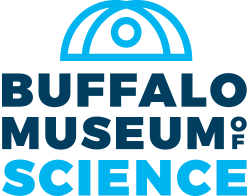Elephant Birds (Aepyornis maximus) went extinct on Madagascar between 1000 and 1700 AD, and fewer than 40 intact eggs are believed to be in existence in public institutions
BUFFALO, NY (April 23, 2018) – The Buffalo Museum of Science announced today it has made a rare discovery in its collection: a fully-intact Elephant Bird (Aepyornis maximus) egg. The egg, measuring 12 inches long and 28 inches in circumference, and weighing 3 pounds 5 ounces, was mislabeled as a model due to the rarity of this type of egg.
As a part of the Buffalo Museum of Science’s commitment to investing in and supporting its collection, the egg was rediscovered as the oological collection was being inventoried and cataloged to current museum standards. Further investigation into the archival record revealed the egg was purchased from Edward Gerrard & Sons of London in 1939. Cast eggs are commonplace in museum collections, so, wanting to authenticate their rediscovery, Museum staff turned to the experts at the Patricia H. and Richard E. Garman Art Conservation Department at SUNY Buffalo State. Conservators radiographed the egg and confirmed it was, in fact, real.
The Buffalo Museum of Science joins the ranks of world-class institutions like the National Geographic Society, Denver Museum of Nature and Science, Natural History Museum, London and The Field Museum in Chicago that own intact Aepyornis eggs. Dr. Jeff Stephenson, Zoology Collections Manager at the Denver Museum of Nature and Science, has noted the Buffalo Museum of Science’s discovery has added to the world’s inventory of less than 40 intact eggs held in public institutions.
“Lost, hidden or misidentified artifacts and specimens are not uncommon in museums that have been collecting for centuries, and we are thrilled to rediscover this rare egg in our collection,” said Director of Collections, Kathryn Leacock. “The Buffalo Society of Natural Sciences has been collecting since 1861, and as we continue to care for the collection, there is always more to learn and discover.”
The flightless Elephant Bird was endemic to the island of Madagascar. Likely named for its thick legs, they averaged 10-feet in height and weighed between 770 and 1,100 pounds. Elephant Bird eggs are known as the largest eggs ever laid by any vertebrate, including dinosaurs, with some eggs measuring up to 13 inches in length.
Elephant Bird eggs are rare, both inside and outside of the museum world. In March 2011, renown broadcaster and naturalist Sir David Attenborough presented a BBC documentary “Attenborough and the Giant Egg” about his personal quest to discover the secrets of the Elephant Bird. Today, any Elephant Bird eggs found in Madagascar are property of the Malagasy government.
The Buffalo Museum of Science will unveil the Elephant Bird egg to the public On May 1, 2018 as part of the Rethink Extinct science studio.
For additional information about the Buffalo Museum of Science, including Museum hours, visit http://www.sciencebuff.org.
ABOUT THE BUFFALO MUSEUM OF SCIENCE
Rooted in the belief that science creates opportunities and shapes our world, the Buffalo Museum of Science is a non-profit educational institution dedicated to providing relevant science programming to learners of all ages in the Buffalo Niagara region. Through interactive science studios and exhibits designed for multi-generational learning, the Museum showcases its extensive collection of more than 700,000 specimens and artifacts representing all facets of the natural world with an emphasis on Western New York. With a focus on raising the science literacy in the Buffalo Niagara area and beyond, the Museum offers hands-on workshops, camps, panel discussions, guided tours and enhance learning opportunities for its guests and community. Opened in 1929 in Buffalo’s Olmsted-designed Martin Luther King, Jr. Park, the Museum recently installed its eighth interactive science studio marking the completion of the Museum’s 9-year-long transformation of its guest experience. The Buffalo Museum of Science is governed by the Buffalo Society of Natural Sciences alongside Tifft Nature Preserve in South Buffalo, a 264-acre urban wetland preserve on reclaimed former industrial land. Learn more at www.sciencebuff.org.
Contact:
Andrea Gallagher
Director of Marketing & Public Relations
716.896.5200 x312

